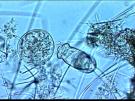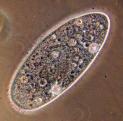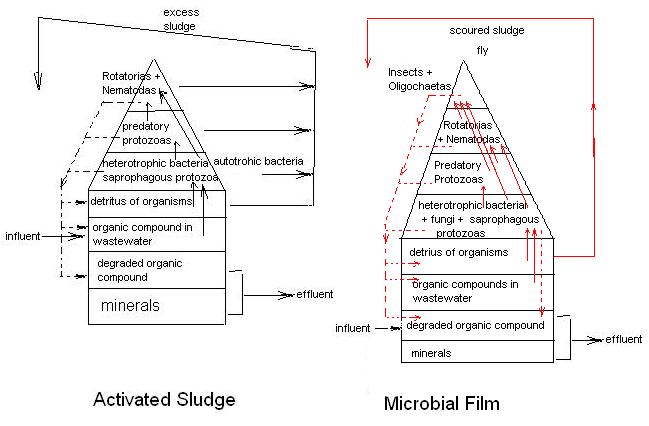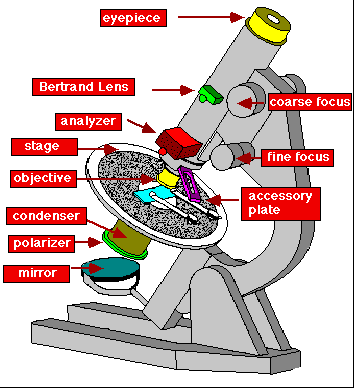相关网页:
English Version: Wastewater
Microbes/Microorganisms Photographic Catalogue: Photos Pictures:
amoebae flagellates ciliates protozoans protozoon vorticella rotifers
nematodes algae fungus/fungi
Young sludge: Amoebae and flagellates predominate with a few free swimming ciliates. 年轻的污泥中含有较多的变形虫(阿米巴,amoeba,也作ameba,复数形式为?)和鞭毛虫(flagellates),也有一些自由游动的纤毛虫。变形虫借助于伪足进行运动和捕食,导致形体一直变化。
Mature sludge: For municipal wastewater treatment plants the most desirable stage of the ecological succession is the stage where both stalked ciliates and free swimming ciliates are observed with possibly a few rotifers. This stage is is correlated with rapid settling of solids and easy separation of solids from water. The resulting effluent is correspondingly low in turbidity, suspended solids and biochemical oxygen demand (BOD). 成熟的污泥是污水厂最想要的,往往同时含有有柄的纤毛虫(柄纤毛虫, stalked ciliates)和自由游动的纤毛虫(free swimming ciliates)。并且同时看到一些轮虫(rotifers)。
Older sludge are characterized by increasing numbers of rotifers and nematodes with fewer stalked ciliates. 较老的污泥中轮虫和线虫(nematodes)增加,有柄(茎)的纤毛虫(stalked ciliates)减少。
Both the young and the old sludge are associated with poor settling and high effluent turbidity. Both are conditions municipal wastewater treatment operators strive to avoid.
其他参考:
微生物的指示作用
(1) 着生的缘毛目多时,处理效果良好,出水BOD5和浊度低。(如小口钟虫、八钟虫、沟钟虫、褶钟虫、瓶累枝虫、微盘盖虫、独缩虫)这些缘毛目的种类都固定在絮状物上,并随窗之而翻动,其中还夹杂一些爬行的
栖纤虫、游仆虫、尖毛虫、卑气管叶虫等,这说明优质而成熟的活性污泥。
(2) 小口钟虫在生活污水和工业废水处理很好时往往就是优势菌种。
(3) 如果大量鞭毛虫出现,而着生的缘毛目很少时,表明净化作用较差。
(4) 大量的自由游泳的纤毛虫出现,指示净化作用不太好,出水浊度上升。
(5) 如出现主要有柄纤毛虫,如钟虫、累枝虫、盖虫、轮虫、寡毛类时,则水质澄清良好,出水清澈透明,酚类去除率在90%以上。
(6) 根足虫的大量出现,往往是污泥中毒的表现。
(7) 如在生活污水处理中,累枝虫的大量出现,则是污泥膨胀、解絮的征兆。
(8) 而在印染废水中,累枝虫则作为污泥正常或改善的指示生物。
(9) 在石油废水处理中钟虫出现是理想的效果。
(10) 过量的轮虫出现,则是污泥要膨胀的预兆。
另在一些对原生动物不宜生长的污泥中,主要看菌胶团的大小用数量来判断处理效果。
看本页之前,可以先看看另外几个污水处理常见微生物图片的网页:
http://content.edu.tw/junior/bio/tc_wc/textbook/apa/text-apa-1.htm
[繁体中文]
http://xianwei.8849.cn/yuansheng/yuansheng.htm
http://co.163.com/forum/content/91_159817_1.htm
http://www.cnjlc.com/Article/200512/5644.html
http://www.microscope-microscope.org/applications/pond-critters/protozoans/ciliphora/ciliophora.htm
http://www.microimaging.ca/protozoa/
活性汚泥動物園(日文)
Taxonomic Data Access
Wastewater Microbes Pictures
| 类目 | 英文和中文名称 | 图片 | 视频影像 | 体积大小(μm) | 特征,指示作用 |
| amoeba ameba 变形虫,阿米巴 |
 |
几十~几百 | ||
| flagellates 鞭毛虫 | Pigmented flagellates (single-celled) |  |
小于十~几十 | |
| 缘毛(目) Peritrichida (Order) | ||||
| Phylum Protozoa | ciliates 纤毛虫 | 几十~几百 | ||
| 柄纤毛虫 Stalked Ciliates |
 |
|||
| free swimming ciliates 自由游泳的纤毛虫 | ||||
| Vorticella (Genus) 钟虫(属) |
 |
40~175 | 着生 | |
| 小口钟虫 Vorticella Microstoma |  |
|||
| 大口钟虫 | ||||
| 八钟虫 Vorticella Octava | ||||
| 沟钟虫 Vorticella Convallaria | ||||
| 褶钟虫 | ||||
| 星云钟虫 | ||||
| 微盘盖虫 | ||||
| 独缩虫 | ||||
| 栖纤虫 | ||||
| 游仆虫 | ||||
| 尖毛虫 | ||||
| 卑气管叶虫 | ||||
| Paramecium 草履虫 |
 |
|||
| 累枝虫 Epistylis | ||||
| 瓶累枝虫 Epistylis Rotans | ||||
| 盖虫 | ||||
| 寡毛类 (环节动物) Oligochaete | ||||
| 根足虫 Rhizopod (根足纲 Rhizopoda) | ||||
| 多细胞动物 | rotifers 轮虫 |
|
过量出现为污泥要膨胀的预兆 | |
| 多细胞动物 | nematodes 线虫 |
|
大个头(相比前面的各种微生物) | |
| algae 藻类 | ||||
| fungus, fungi 真菌 |
以上列表主要通过对各微生物中英文名称进行图片搜索得到,如有错误之处,欢迎您指出。您也可以通过本站上方和右方的搜索引擎进行搜索,查找更多图片。建议找到正确的英文名称后进行图片搜索并将搜索结果进行互相对照并查阅书本等,以保证您找到的图片是正确的。
另外,建议参考 APHA AWWA 的标准水样测试方法 手册上的附图。
Wastewater organisms : a color atlas / Sharon G. Berk and John H. Gunderson.
生物分类
原核生物(prokaryote,也作procaryote) 真核生物(eukaryote,也作ecaryote) 原生动物 真菌
硝化菌,反硝化菌,聚磷菌等
Filamentous bacteria
Filamentous bacteria, or bulking bacteria occur in activated sludge plants or lagoons. Low numbers of filaments are thought to be helpful by pulling pin flocs together so flocs become heavy enough to settle.
See pictures of filamentous bacteria filaments 丝状菌.
 filamentous bacteria 丝状菌 |
Amoebae
Amoebae are some of the earliest organisms to be observed as the activated sludge process develops. They are associated with "young sludge". They move and eat by sending out "false feet", pseudopods, that serve both for locomtion and to engulf small particles of organic material and bacteria.
Flagellated Protozoans
flagellated protozoans range in size, shape and number of flagella. A flagellum is a tail-like structure comprised of protein that whips back and forth causing the organism to move through the water. Most flagella push the protozoan; a few protozoans have flagella that pull them through the water. One or more flagella may occur at either end of the protozoan.
See pictures of Flagellated Protozoans, flagella, 鞭毛虫。
Ciliated Protozoans
Ciliated protozoans have hair-like structures all over the surface of the cell, also made of protein, that wave back and forth causing the organism to move. These organisms engulf bacteria and small particles for food, with some of the larger ciliates that pry on smaller ciliates and flagellates. They occur at about the same time in sludge succession as the flagellated protozoans.
See pictures of ciliated protozoans,纤毛虫.
Stalked Ciliated Protozoans
Stalked ciliated protozoans are the organisms most highly regarded by sewage waste treatment operators. They are associated with sludge that settles readily and with low suspended solids in the supernatant from the clarifier. The stalk is stuck to the floc so the organism is "rooted" in the floc. The body of the ciliate is perched on the end of the stalk with cilia at the opposite end from the stalk. The cilia wave back and forth producing a current that sweeps small praticles and bacteria into the cell. Te stalk is actually spring-like and coils slowly into a spring. Periodically the spring releases and the coil stretches in a new direction taking the body of the protozoan to a new area where more particles and bacteria can be swept into the body of the ciliate by the cilia. Some forms have immature stages that lack a stalk, but have cilia.
See pictures of Vorticellar 钟虫, one type of typical ciliated stalked protozoans. It has one cell at the end of stalk.
Other types with branched stalks and multiple cells include Epistylis, Carchesium, and Opercularia.
Protozoan Cysts
When environmental conditions (pH, temperature, concentrations of nutrients, waste products and toxic compounds) are adverse, many protozoan have the ability to foam cysts. Cysts have cell walls resistant to low or high pH, low or high temperature, toxins and drying. Since the cell is not metabolizing, food and other materials outside the cell are not being taken into the cell. the strategy is for the organism to avoid contact with the environment and remain alive until the environment improves. Cysts can also occur as a result of reproduction.
See pictures of protozoan cysts.
Rotifers
Rotifers are multicellular organisms with an alimentary tract, muscles and a reproductive system with most being female. At the head end are cilia that sweep bacteria and particles into the animal. Some rotifers have heavier cilia that provide locomotion in addition to sweeping small particles into the mouth. One prominent feature of the digestive system is the mastax which is comprised of muscles surrounding a series of sclerotized jaws that macerate the food particles. Some sewage plant staff prefer to see more rotifers in their activated sludge tan others do. For these plants settling is optimized when more totifers are observed. In some plants more than a few rotifers are associated with old sludge and plant staff increase sludge wasting.
Nematodes
Nematodes are roundworms with a mouth at one end, an alimentary tract and anus at the other. In the wastewater treatment plant they feed on detritus - small particles of organic material including bacteria. Some forms are predators that eat protozoa, rotifers and other nematodes. Nematodes are associated with old sludge. When seen in the sludge in substantial numbers operating staff typically increase wastage rates.
Pictures of netmatodes 线虫.
Algae
Pretreatment facilities associated with food plants typically have evolved over many year. Food canning, freezing, package dinners, milk and cheese plants, and slaughter houses are often located near rural areas where their raw materials are raised. Land costs were relatively inexpensive, particularly at the time many plants were constructed. In the 1960s and 1970s it was common practice to dig another hole to store dirty water when another restriction occurred. The result is often a series of lagoons or ponds frequently totaling several millions of gallons. Over the years discharge regulations have become more strict and suburbia has often grown closer to the plant. The lagoons are aerated and the first one or two lagoons behave as an activated sludge treatment system and contain the organisms described above. Subsequent lagoons in the system often are green as a result of algae growth. The algae contribute to total suspended solids and may be responsible for total suspended solids being over the discharge limit. For ponds with a goal to remove phosphorous from solution, the algae may serve a purpose. In these cases a method to collect and harvest the algae is necessary so the phosphorus is removed. Another alternative is to consider a constructed wetland and growing aquatic plants as well as algae.
Algae:
Filamentous Fungi
Filamentous fungi have also been collected from food plants with lagoons. Compared to bacteria, fungi require long periods of time to grown, a doubling time of a few hours for bacteria compared to days for fungi. Fungi grow from a spore or a piece of vegetative hypha. The walls of many fungi contain the biopolymer chitin, the same material that comprises the tough exoskeleton of insects. They knot together as strands of spaghetti or a mat of long hair. The knot or mat serves as a net to catch smaller particles with the result that equipment can be clogged. Fungi play an exceedingly important role in decomposing trees and fallen leaves in forests. Thermalphilic (heat-loving) fungi are important in composting operations. In wastewater treatment lagoons they appear to indicate a long retention time and some opportunities to improve the operation of the wastewater treatment scheme.
The values of specific growth rates of various microorganisms are listed in the following table. [source: Wastewater Treatment with Microbial Films, by Shigehisa Iwai, Takane Kitao, P15, Technomic Publishing Company, Inc. 1994]
Growth Rates of Microbes
| Growth Rate Parameters | Temperature |
Dry Weight of a Cell | |||
| Microbes | µ(1/day) | td (hr) | (°C) | (mg) | |
| Bacteria | Bacillus megatherium | 31.8 | 0.52 | 30 | 3.8E-9 |
| Escherichia coli | 59.1 | 0.28 | 37 | 4.0E-10 | |
| Rhodopseudomonas spheroides | 6.9 | 2.4 | 34 | - | |
| Nitrosomonas sp. | 1.3 | 12.7 | 25 | - | |
| Staphylococcus aureus | 37.6 | 0.44 | 37 | 1.5E-10 | |
| Algae | Anabaena cylindrica | 0.66 | 25.0 | 25 | - |
| Microcystis aeruginosa | 0.64 | 25.9 | 25 | - | |
| Navicula minima | 0.97 | 17.1 | 25 | - | |
| Chlorella ellipsoidea | 2.5 | 6.7 | 25 | - | |
| Selenastrum capriconnutum | 1.9 | 8.7 | 25 | 1.9E-8 | |
| Fungi | Saccharomyces cerevisiae | 8.3 | 2.0 | 30 | 7.1E-8 |
| Protozoa | Vorticella microstoma | 3.3 | 5.0 | 20 | 3.9E-6 |
| Epistylis plicatilis | 1.6 | 10.2 | 20 | - | |
| Colpidium campylun | 3.6 | 4.7 | 20 | 1.6E-6 | |
| Paramecium caudatum | 1.4 | 12.0 | 20 | 3.0E-4 | |
| Tetrahymena pyriformis | 5.3 | 3.1 | 25 | 1.4E-6 | |
| Colpoda steinii | 5.5 | 3.0 | 30 | 1.2E-6 | |
| Stentor coeruleus | 0.75 | 22.1 | 19 | 5.0E-3 | |
| Aspidisca costata | 1.2 | 13.6 | 20 | - | |
| Metazoa | Rotaria sp. | 0.28 | 59.1 | 20 | - |
| Philodina sp. | 0.23 | 72.0 | 20 | 1.8E-4 | |
| Lecane sp. | 0.31 | 54 | 20 | - | |
| Aeolosoma hemprichi | 0.35 | 47.3 | 20 | 3.8E-4 | |
| Nais sp. | 0.12 | 138 | 20 | 6.6E-3 | |
| Pristina sp. | 0.12 | 138 | 20 | - | |
| Dero sp. | 0.07 | 238 | 20 | - | |
Difference Between Bacteria (procaryotes) and Protozoans, Algae and Fugi (eucaryotes)
Intracellular organelles (small organs inside the single cell) can be seen on many of these photomicrographs of amoebae and protozoans. Intracellular organelles include the nucleus of the cell, food vacuole, and other specialized structures. Organelles are surrounded by a membrane that separates them from the rest of the cell. Digestive enzymes are secreted into food vacuoles to digest the food particle and avoid exposure of the rest of the cell to the enzymes. Bacteria lack intracellular structures that are visible with light microscopy.

"Hawkes comparing the biotas of trickling filter slime and activated sludge, have shown in the figure above. As metazoas (Rotatoria, Nematoda, Insecta, Shellfish, Oligochaeta, etc) are all large-sized, whose length ranges from several millimeters to a few centimeters, and who prey on film microbes diligently, resulting in a remarkable decrease of excess sludge productions. Moreover, an ecosystem with highly diverse biota is a stable system which enables a stable treatment effect inevitably. Those bacteria, who utilize substrates slowly assimilated or substrates with low value of growth yield, always have relatively small specific growth rates. Therefore, mcirobial film processes have excellent performance in removing such substrates."
Hawkes对活性污泥与滴滤池泥浆进行比较,如上图所示。后生动物体积都较大,从几毫米到几厘米不等,并以捕食生物膜上的微生物为生,所以导致多余污泥产量的减少。 另外,具有多样性生物的生态体系比较稳定,所以处理效果也稳定。那些食用消化较慢的基质或者生长产率较低的基质的细菌,比生长速率通常较低。所以生物膜去除此类 基质的效果很好。
source: Wastewater Treatment with Microbial Films, by Shigehisa Iwai, Takane Kitao, P16, Technomic Publishing Company, Inc. 1994
Process Conditions Versus Organisms Present/Population
| Process Conditions |
Organism Population |
| Poor BOD5 and TSS Removal Mainly dispersed bacteria No floc formation Very cloudy effluent |
Predominance of amoeba and flagellates A few ciliates present |
| Poor Quality Effluent Dispersed bacteria Some floc formation Cloudy effluent |
Predominance of amoeba and flagellates Some free-swimming ciliates |
| Satisfactory Effluent Good floc formation Good settleability Good clarity |
Predominance of free-swimming ciliates Few amoeba and flagellates |
| High Quality Effluent Excellent floc formation Excellent settleability High effluent clarity |
Predominance of stalked ciliates Some free-swimming ciliates A few rotifers A few flagellates |
| Effluent High TSS and Low BOD5 High settled sludge volume Cloudy effluent |
Predominance of rotifers Large numbers of stalked ciliates A few free-swimming ciliates No flagellates |
Source: Frank R. Spellman, Spellman’s Standard Handbook for Wastewater Operators, Fundamental Level, Volume 1, Technomic Publishing Company, 199, Page 157
Microscopes 显微镜构造
通过显微镜可以观察微生物,通过显微镜和数码相机的结合应用可以对微生物进行拍照。

Particle Size 微粒大小的计算方法
Particle size can be determined from the photomicrographs using the
following equation:
从拍到的照片,微粒大小可以用以下的公式计算。
Particle size = (Dimension/Magnification) x 1000
微粒大小(以微米为单位)=相片上的微粒尺寸(以毫米计)× 1000 ÷ 放大倍数
乘以1000是为了把微粒大小的单位换算成为微米。
The 1000 multiplier converts mm to micrometers (microns, 1 微米 = 10exp-6 m). Particle size is expressed in micrometers.
To search for images/pictures/photos of the microorganisms, try the following image search engines:
建议您使用以下图片搜索引擎找寻更多污水处理微生物图片。
http://images.search.yahoo.com/
Related Info
污水处理与环境微生物分类名录